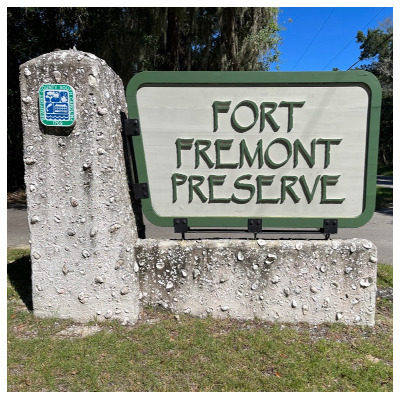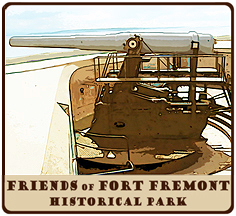HISTORY of FORT FREMONT

The Modern Era of Coastal Defense
Concrete, Steel & Breech-Loading Rifles
In 1885, President Grover Cleveland, through his Secretary of War, William Crowninshield Endicott, established a Board of Fortifications to review the status of all coastal defense fortifications. The Board reported that the improved weapons technology of high velocity breech-loaded cannons rendered the existing coastal defense systems obsolete. The Endicott Board recommendations led to a large scale modernization program for harbor and coastal defense in the United States.
When the war with Spain loomed in 1898, construction of coastal batteries was authorized by Congress under the $50 million Harbor Fortification Defense Act. The historic significance of Fort Fremont is that it is representative of the new coastal defenses built during this period with its upgraded design, and new weapons systems.

U.S. Naval Station Port Royal
Port Royal Sound is one of the largest natural deepwater harbors on the Atlantic Coast. During the Civil War, after contributing to the sack of Beaufort, the Union Army's South Atlantic Blockading Squadron established a base here for fleet repairs and a coaling station.
In 1891-1895 a dry dock was built at the Naval Station; the only one south of Norfolk, Virginia. It served as a strategic support base for the emerging Atlantic Fleet. Twenty-two naval ships visited the Station including the Battleships USS Maine, USS Massachusetts, USS Texas, and USS Indiana. The USS Maine made its last stop for provisions in Port Royal before leaving for its last voyage to Havana, Cuba, and the start of the Spanish American War.
Fort Fremont was built in 1899 by the Army Corps of Engineers using local labor on condemned private property on Saint Helena Island across the Beaufort River from the Naval Station. It was designed to play a vital role in the protection of the strategic dry dock and coaling station which remained critical to the Atlantic Fleet during the Spanish American War period.
The Fremont Batteries
Fort Fremont was one of six fortifications designed to protect the southeastern coast during the Spanish American War. The fort site eventually consisted of 170 acres with numerous outbuildings, including an administration building, guard house, barracks, hospital, stable, mess hall, bakery, commissary, post exchange, lavatory, and water tower. It was manned by a force of up to 110 personnel.
The main weapon systems consisted of Battery Jesup, which included three 10-inch breech-loaded disappearing cannons, and Battery Fornance which had two 4.7-inch rapid fire guns. These five gun emplacements, built behind bastions of earth, logs and concrete became some of the highest ground on the coastal islands.
In 1898, during the Spanish-American War and while the Fort Fremont was under construction, the fort site and temporary batteries were manned by a succession of detachments from the South Carolina Naval Militia, 2nd North Carolina Volunteer Infantry, and the Heavy Battery, South Carolina Volunteer Artillery. From 1899 until 1901, Fort Fremont was manned by detachments of the regular army drawn from the 6th Infantry and 1st and 2nd Artillery Regiments. In 1901 the Army Artillery Branch was divided into field artillery and coast artillery. From 1901 through 1911, the 16th, 117th, and 127th Coast Artillery Companies successively manned the fort. In 1911 the 127th was transferred to Texas and thereafter caretaker detachments from Fort Screven were assigned to Fort Fremont until its abandonment in 1920.
The Land's End Light
In June 1910, violence erupted between artillerymen at the fort and African-American civilians involving the sale of moonshine by the locals. Following several fights, six soldiers were wounded and one killed. Isaiah Potter, arrested for the fatal shooting, claimed that the trouble began with what the Beaufort Gazette called "intimacy between his wife and a private soldier" who was identified as Pvt. Frank J. Quigley. A local legend identifies Quigley as the ghostly Land's End Light.
Deactivation and Privitization
As early as 1906, the War Department gave serious consideration to the closing of Fort Fremont, due to budgetary constraints. In 1908, the general public could tour the fort and its weapon emplacements. In 1911, only a small detachment of soldiers of the 116th Company Coastal Artillery from Fort Screven, GA, remained at the post following transfer the 127th Company to Fort Sam Houston (Galveston, TX). The guns at Fort Fremont stayed on the fort until World War I.
Fort Fremont was officially deactivated in 1912 and the land was put on the market in 1921.
Several private individuals aquired the property on Saint Helena Island over the years with various plans which by 1946 resulted in platting the property into beach lots. In 1951, Mr. and Mrs. G. B. Schurmeir renovated the hospital structure into a hunting and fishing lodge. In 1972, the concrete gun emplacements were the property of Mr. and Mrs. G. G. Dowling.
In May of 1989, the batteries and the hospital building (still a private residence) were both listed in the National Register of Historic Places.
THE FUTURE of FORT FREMONT
Over time, the land grew over with maritime forest and the ruins of the fort became an attractive nusiance. In October 2004, The Trust for Public Land and the Beaufort County Council paid $5.4 million to two landowners in order to transform the remnants of Fort Fremont into a beachfront park. Minor improvements, cleanup, a sign and fencing were installed. The Beaufort County Council allocated funds to improve the preserve, The Friends of Fort Fremont installed temporary interpretive signage, stairs and railings, and cleaned the external graffiti. Final design plans for major park improvements have been approved by the County and the Friends.
Construction of the History Center at Fort Fremont was completed in 2021 with a grand opening celebration in November. Please see the photos of construction and a video of the opening gala at our History Center Page.
QUICK NOTES ON FORT FREMONT - Docent Tour
Most Saturdays Friends of Fort Fremont will provide docent-led tours at the Preserve. to arrange to meet your guide(s) during the open hours 10:00 am to 4:00 pm at the History Center.
- 1. Why was Fort Fremont built?
- 1.1 Ft. Fremont was built in response to the outbreak of the Spanish-American War in April 1898.
- 1.2 Ft. Fremont's mission was to defend Port Royal Naval Station on Parris Island.
- 2. What was so important here that needed to be defended by a fort?
- 2.1 Port Royal Sound is the deepest natural harbor between New York and Key West.
- 2.2 Port Royal Naval Station in 1898 was a critical part of the U.S. Navy's network of coaling stations for warships and had the only dry dock in the South capable of holding the modern battleships and heavy cruisers the U.S. Navy was beginning to build and deploy.
- 2.3 Fort Fremont was part of the Endicott-era fort system built from 1890 to WWI which provided then state-of-the-art coastal defense against new battleships and heavy cruisers of the era.
- 3. When was Fort Fremont built?
- 3.1 Ft. Fremont was authorized on 6 April 1898, 6 weeks after the USS Maine sank in Havana, Cuba and 2-1/2 weeks before war was formally declared.
- 3.2 Temporary batteries were in place and submarine mines were deployed in the Beaufort River during the Spanish-American War.
- 3.3 The concrete batteries we see today and initial supporting administration and barracks buildings that no longer exist were built 1898-1899.
- 3.4 The U.S. Army occupied the fort from 1898 through 1911.
- 4. Why was Fort Fremont abandoned?
- 4.1 Port Royal Naval Station was moved to Charleston, SC, and in 1909 a new dry dock was opened in Charleston to replace the one on Parris Island.
- 4.2 Ft. Fremont's mission to protect the Naval Station and dry dock no longer existed.
- 4.3 1911 - Ft. Fremont troops transferred to Ft.Crockett at Galveston, TX.
- 4.4 1912 - Sec. Of War directs Ft. Fremont be placed out of commission.
- 4.5 1930 - Ft Fremont property purchased by Frederick Barns of NY.
- 4.6 2004 - Property acquired by Beaufort County as a historical site.
- 5. Who was stationed at Fort Fremont?
- 5.1 During the Spanish-American War (1898), the temporary batteries were manned successively by Navy personnel, 2nd NC Volunteer Infantry, and a detachment of the Heavy Battery, SC Volunteers. The submarine mines were under the control of the Army Corps of Engineers.
- 5.2 1899 - 6th Infantry, subsequently Battery K, 2nd Artillery Regiment.
- 5.3 1901 - U.S. Army divides Artillery Branch into Field Artillery and Coast Artillery.
- 5.4 1901 - 1904: 16th Coast Artillery Company
- 5.5 1904 - 1907: 117th Coast Artillery Company
- 5.6 1907 - 1911: 127th Coast Artillery Company
- 6. What were the defenses of Fort Fremont?
- 6.1 Battery Jesup (large concrete battery) mounted three 10-inch guns on disappearing carriages.
- 6.1.1 Intended to duel directly with large capital warships (battleships and heavy cruisers).
- 6.1.2 Maximum range: 8 miles (would reach almost 1/2-way across Hilton Head)
- 6.1.3 Projectile weight: 510 to 617 lb depending on projectile type.
- 6.1.4 Rate of fire: 1 round per minute.
- 6.1.5 The disappearing carriages used a large lead weight in a circular hole under the gun (visible today at Battery Jesup) to control the gun position.
- 6.1.5.1 After loading and the azimuth and elevation of the gun were received from the plot room and fire control tower, the weight was released pulling the gun up to fire over the concrete parapet.
- 6.1.5.2 The recoil when the gun fired forced the gun back behind the parapet and simultaneously lifted the weight.
- 6.1.5.3 The weight was locked into place, the gun reloaded, and a new azimuth and elevation could be reset for a new target or to correct the previous shot.
- 6.1.5.4 The gun was then ready to have the weight released to fire again - all of this took one minute.
- 6.1.5.5 The disappearing carriage allowed the gun to be only exposed to counterfire for a matter of seconds.
- 6.1.5.6 The disappearing carriage would be made obsolete with the development of effective military aircraft in WWI.
- 6.1.6 Target range, bearing, and course were determined by measurements using essentially specialized surveying equipment in a fire control tower (foundation still visible on Triangle Road) that were relayed by phone to a plot room below gun pit three (southernmost gun) where the calculations were made to determine a firing solution for each gun.
- 6.2 Submarine Mines
- 6.2.1 Electrically detonated mines were to be deployed in the Beaufort River to prevent enemy ships from running past Ft. Fremont.
- 6.2.2 The Army had plans to allow mining the East Coast in 3 days if necessary.
- 6.2.3 The mines for Ft. Fremont were stored at the arsenal in Augusta.
- 6.3 Battery Fornance (small concrete battery) mounted two 4.72-guns on pedestal mounts (shot directly over the parapet and were not disappearing carriages)
- 6.3.1 Intended to prevent small boats from clearing the minefield.
- 6.3.2 Maximum range: 6.3 miles
- 6.3.3 Projectile weight: 45 lb
- 6.3.4 Rate of fire: 6 rounds per minute
- 6.1 Battery Jesup (large concrete battery) mounted three 10-inch guns on disappearing carriages.
- 7. What happened to the guns?
- In 1918, two 10-inch guns went to France for WWI, and one went to Sandy Hook Proving Ground, NJ where it was eventually scrapped. The 4.72-inch guns remained until 1920 when they were sent to Aberdeen Proving Grounds, MD. In 1926 one was donated to Confluence, PA; both guns were eventually scrapped.
- 8. How big was a Coast Artillery Company?
- 8.1 In 1906, it consisted of 109 enlisted men and three officers.
- 8.2 The commanding officer was a Captain.
- 8.3 Historical footnote: In 1950 Field and Coast Artillery merged again into a single Artillery Branch (airplanes had made Coast Artillery obsolete). In 1968 Artillery again split into Field Artillery and Air Defense Artillery. Air Defense Artillery inherited the unit numbers and many of the traditions of the old Coast Artillery. Today, it looks like Air Defense Artillery and Field Artillery are on the verge of merging again.
- 9. What was at Fort Fremont?
- The fort consisted of 170 acres. The two concrete batteries on the tour today are only a portion of the original fort. To the north (towards Beaufort), the rest of the fort consisted of barracks, mess hall, PX, officer and NCO quarters, administrative and engineering buildings, hospital, and stables. Today only the brick hospital survives as a private residence which is on the tour. Ft. Fremont was a small military village.
- 10. What was life at Ft. Fremont like?
- Coast Artillery was generally considered good duty, compared to other Army branches such as infantry, cavalry, or field artillery. Training was constant in order to maintain proficiency with the complex guns and firing systems, calisthenics were daily except Saturday and Sunday, nighttime drills were a weekly part of the training, inspection by higher headquarters and live fire drills were periodic requirements. The guns themselves required constant maintenance. However, by mid-afternoon, duties were essentially done, and soldiers actively participated in athletics (baseball being especially popular) against local civilian teams traveling as far as Hampton where the 1906 game attracted 700 spectators. The fort also had a popular minstrel troop that put on shows throughout the local area. The fort's personnel were active in local civilian social pursuits including dinners, dances, outings on the local waters, hunts, and fishing expeditions. Several of the men of the fort married local women, and some descendants of these unions still reside in Beaufort County. The division between officers and enlisted was much more distinct in this era than in the modern military. In 1899 a private's pay was $13 - $18/month, a sergeant $15 - $20/month, a lieutenant $116 to $125/month, and a captain $150/month.
- 11. Was Fort Fremont ever in combat?
- No; none of the Endicott-era forts were ever in combat, but simply served as a deterrence against attack—much as nuclear deterrence did in the Cold War. During WWII a Japanese submarine fired on one of the Endicott-era forts in Oregon, and the ones in the Philippines were part of the defense against the Japanese invasion. However, by then they had undergone many upgrades and were quite different from the original Endicott-era fort.
- 12. What is important about Fort Fremont?
- 12.1 Ft. Fremont serves as a historical remnant of military defense technology at the dawn of the 20th century as the U.S. became a major world power. No forts were on this site before and none afterwards so the Ft Fremont historical site provides an unspoiled snapshot of this brief period in time.
- 12.2 In its day, Ft. Fremont represented the state-of-the-art military technology against the predominant threat of the era - seaborne attack by modern steam-driven battleships mounting modern steel breech-loading guns of large caliber (8 to 12-inch) firing shells of unprecedented size and doing so with exceptional accuracy. Ft. Fremont used the same modern guns as the battleships it was designed to oppose, combined with a sophisticated fire control system and innovative defense structures and camouflage. The fort generated its own electrical power, had modern lighting, running water, telephone communication, and even the forerunner of the fax machine as part of the fire control system.
- 12.2 For 350 years, starting with the French in 1562, Europeans and their descendants built fortifications to defend the great harbor provided by Port Royal Sound. Fort Fremont was the last fort in this long local history of coastal forts and the sole remnant that we still have available to see.






